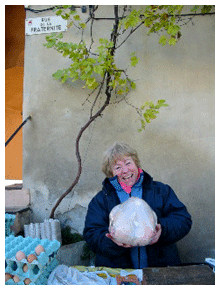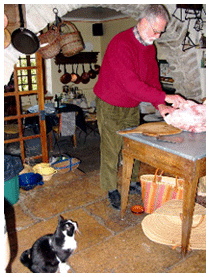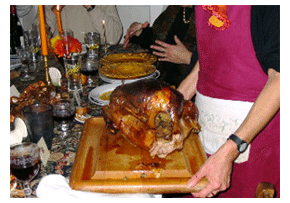Living in Provence: Thanksgiving

- SUBSCRIBE
- ALREADY SUBSCRIBED?
BECOME A BONJOUR PARIS MEMBER
Gain full access to our collection of over 5,000 articles and bring the City of Light into your life. Just 60 USD per year.
Find out why you should become a member here.
Sign in
Fill in your credentials below.
 NYONS, FRANCE. Thanksgiving arrived here last week on the Rue Balzac. I had placed my order for a large fresh turkey a month ago with Caty, the poultry and egg lady at the Thursday Nyons market. Her turkeys are by far the best. Since the French do not eat whole turkeys (except in some regions at Christmas), they are not readily available and are pricier than the finest aged filet mignon or Porterhouse steak in the US.
NYONS, FRANCE. Thanksgiving arrived here last week on the Rue Balzac. I had placed my order for a large fresh turkey a month ago with Caty, the poultry and egg lady at the Thursday Nyons market. Her turkeys are by far the best. Since the French do not eat whole turkeys (except in some regions at Christmas), they are not readily available and are pricier than the finest aged filet mignon or Porterhouse steak in the US.Turkeys are thought to have been introduced into France in the mid-1500s. The 19th-century French gastronomic writer Alexandre-Balthazar-Laurent Gromod de la Reynière claims the bird was a rare enough delicacy that it was first served at the wedding banquet of King Charles IX to Elizabeth of Hapsburg in 1570, though Margaret of Navarre is said to have bred the birds in Alençon 36 years earlier. Other sources credit the Jesuits with having become enamored of these gallinaceous fowl during their 1518 trip to Mexico with Cortez, bringing some back to Spain on their return and later introducing them into France. Opinions and theories abound. Alexandre Dumas in his 1870 LE GRAND DICTIONNAIRE DE CUISINE insists the birds were brought back from India in 1432 and were called "poulet d’Inde," hence the French dinde. "Some cheap wits," he writes, "have got into the habit of calling turkeys Jesuits. Turkeys have just as much right to resent this name calling as the Jesuits would if they were called turkeys."
Thursday morning, I arrived early at the market. Most of my food shopping and a lot of the cooking had been done the day before, but there were fresh flowers to buy, girolles for the stuffing and, of course, the turkey to be picked up. I had a day of chopping, basting and sautéing ahead.
As always, there was a line at Caty’s stand in the Place Buffaven. I positioned myself and prepared for a long wait. The crowd was unusually lively; there was a certain excited buzz to the conversation.a href="http://www.autoeurope.com/showspecial.cfm?aff=bonjourparis" mce_href="http://www.autoeurope.com/showspecial.cfm?aff=bonjourparis" target="_blank" rel=”nofollow”> Apparently someone had ordered an enormous turkey the likes of which had never been seen in Nyons. Said turkey was prominently on display, slaughtered, minus its feathers, wrapped loosely in plastic but with everything else, head and feet included, intact. Each customer felt obligated to deliver a commentary after careful examination; a few even gave the poor bird a poke. Based on anecdotal evidence conducted during an informal and unscientific survey, female customers tended to refer to the oversized fowl as a "dindon" (male turkey), while men predominantly called it a "dinde" (female turkey).
Apparently someone had ordered an enormous turkey the likes of which had never been seen in Nyons. Said turkey was prominently on display, slaughtered, minus its feathers, wrapped loosely in plastic but with everything else, head and feet included, intact. Each customer felt obligated to deliver a commentary after careful examination; a few even gave the poor bird a poke. Based on anecdotal evidence conducted during an informal and unscientific survey, female customers tended to refer to the oversized fowl as a "dindon" (male turkey), while men predominantly called it a "dinde" (female turkey).
 Fortunately I had brought a cart, as whatever its former gender, the turkey was too heavy to carry. Since I do not cook food with a facial expression, I shlepped the turkey up to the château so Lydie could remove its head, feet and more revolting innards not usable for stock or stuffing. Lydie was not around, so Wayne offered to perform the task, supervised by several of their cats, anxious to help out should maybe the whole raw turkey drop to the floor.
Fortunately I had brought a cart, as whatever its former gender, the turkey was too heavy to carry. Since I do not cook food with a facial expression, I shlepped the turkey up to the château so Lydie could remove its head, feet and more revolting innards not usable for stock or stuffing. Lydie was not around, so Wayne offered to perform the task, supervised by several of their cats, anxious to help out should maybe the whole raw turkey drop to the floor.
Once back home, I preoccupied myself with my much-loved annual ritual of dressing the turkey. First I prepared the slow-simmering stock which would be the base of the Madeira gravy. Next I clarified butter mixed with Madeira and garlic cloves in which to soak the cheesecloth I would drape over the turkey while it cooked. Then the stuffing: I chopped and cubed bread from the corner boulangerie, sautéed mushrooms, shallots, celery, garlic and onions, opened a jar of chestnuts, browned local homemade sausage, cut herbs from the garden and beat several of Caty’s fresh-laid eggs, adding a few pots of yoghurt and mixing it all with my hands in a large yellow-ware bowl that had belonged to my grandmother. I packed the stuffing inside the turkey and under the skin for flavor and wrapped it with the butter-drenched cloth.
The guests arrived at 7 PM. We were eight adults, two preteens, three Americans. My friend Laurie, who is half Cherokee and married to a Frenchman, came with her daughter, Mareva, who was too young to remember the last time she celebrated Thanksgiving. They brought wine from their superb vineyard, Domaine de Deurre. Jo and Steve, who are English and live in nearby Mollans-sur-Ouvèze, arrived with more wine and Jo’s homemade chutney for what would be their first Thanksgiving. Wayne and Lydie walked down from the château bearing Champagne, four dusty bottles of 1997 Chassagne-Montrachet 1er Cru Clos Saint-Jean and an apple pie baked by Lydie.
 Downstairs in the dining room, we began with homemade potiron soup. I said grace in English; Laurie said it in Cherokee; Nick in Scots Gaelic and Annie in Provençal. I added a quickie in Hebrew. We shared a long, leisurely and happy feast and promised to gather together again next
Downstairs in the dining room, we began with homemade potiron soup. I said grace in English; Laurie said it in Cherokee; Nick in Scots Gaelic and Annie in Provençal. I added a quickie in Hebrew. We shared a long, leisurely and happy feast and promised to gather together again next
year for another Thanksgiving à la Provençal.
Among many other achievements, Patricia Fieldsteel has had an award-winning column in THE VILLAGER newspaper since 1997 and has also published in THE NEW YORK TIMES. She is an animal-lover par excellance and is divinely happy in Provence, though from time to time she misses the opera, ethnic food and Law & Order reruns. This is her story.


